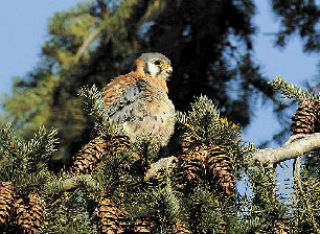If Whidbey birders have their way, Greenbank Farm soon could be home to a resident pair of American Kestrels.
Kestrels are considered one of the most colorful raptors in the world, and a lone male Kestrel has been checking out the farm for several months, to the delight of birders and dog-walkers.
Last week, Whidbey Audubon upped the ante to encourage the Kestrel to find a mate and nest at the farm. They installed the second of two Kestrel nesting boxes.
“Now, we need a female to wander into the area,” said Frances Wood, president of the Whidbey chapter.
“Kestrels are cavity nesters,” said Jack Bettesworth of Seattle, who built the boxes.
Bettesworth has conducted extensive raptor research locally, including a multi-year banding study of Whidbey’s Northern Harriers.
“Kestrels won’t ‘build’ a nest,” he said. “They have to find one.”
If they can’t find the right cavity in an old snag, they will look to see what else is available. So Bettesworth built and installed both of the new Kestrel boxes at the farm. As a finishing touch, he lined the floor of both boxes with a cushy layer of shavings.
If Kestrels do elect to nest at Greenbank, they should find the windy spot to their liking. They prefer an open landscape where they can find a headwind in which to hover while waiting to swoop down on prey. A typical meal would be a small mammal or lizard or large insect.
Hank Vyrostek of Lagoon Point, Greenbank Farm’s facilities manager, helped Bettesworth install the boxes and is keeping an eye on them for activity. There is no guarantee the “right” birds will use them. Bettesworth said the boxes might also appeal to Northern Flickers as well.
Anyone who spots the Kestrel and especially who sees it flying to the nesting boxes is asked to report it to Frances Wood of Whidbey Audubon at wood@whidbey.com.



